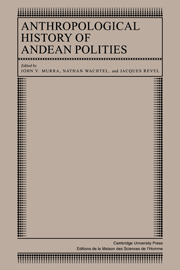Book contents
- Frontmatter
- Contents
- List of contributors
- Preface
- Introduction
- Part I Ecology and society
- 1 The tropical Andes: a changing mosaic
- 2 The evolution of a valley: population and resources of Tarapacá over a millennium
- 3 “Horizons” in Andean archaeology
- Part II The ethnic group and the state
- Part III Systems of classification
- Part IV Symbolic representations and practices
- Part V From ethnic polities to communities
- Bibliography of published source
- Index
3 - “Horizons” in Andean archaeology
Published online by Cambridge University Press: 05 October 2010
- Frontmatter
- Contents
- List of contributors
- Preface
- Introduction
- Part I Ecology and society
- 1 The tropical Andes: a changing mosaic
- 2 The evolution of a valley: population and resources of Tarapacá over a millennium
- 3 “Horizons” in Andean archaeology
- Part II The ethnic group and the state
- Part III Systems of classification
- Part IV Symbolic representations and practices
- Part V From ethnic polities to communities
- Bibliography of published source
- Index
Summary
The process of formation of pristine states is of interest to historians, ethnologists, and archaeologists. Each scholar's experience has encouraged him or her to make a particular selection of the variables, and, on the whole, monocausal proposals have turned out to be as useless as multicausal ones.
I have no intention of going through these schema. Instead, I would like to review some of the features that characterize the central Andean area. These features display two shared conditions: (1) They are very old in the region and recurrent, and (2) the Inka state enlarged their applications to state proportions. Their central features are (1) a system of “archipelagoes,” with resettlement of populations over great distances, the mitmaq; (2) the role played by technology and crafts, with controls exercised over skilled labor; (3) the hydraulic network and controls over water.
Other processes had a more limited distribution: massive migrations or temporary displacements, episodic but sometimes violent – the result of droughts, even famine, changes in climate, or demographic pressures. Such migrations could be at the root of many regional conflicts and play a role in the development of polities to the point where they may have encouraged pan-Andean expansion.
I make no claim that the variables analyzed here cover all pre-Hispanic features that would explain the formation of the Inka state. They do not exclude some that remain unmentioned. The variables that are discussed are not arranged in any hierarchical order, nor do I pretend to elaborate a model of universal validity.
- Type
- Chapter
- Information
- Anthropological History of Andean Polities , pp. 35 - 46Publisher: Cambridge University PressPrint publication year: 1986
- 1
- Cited by



